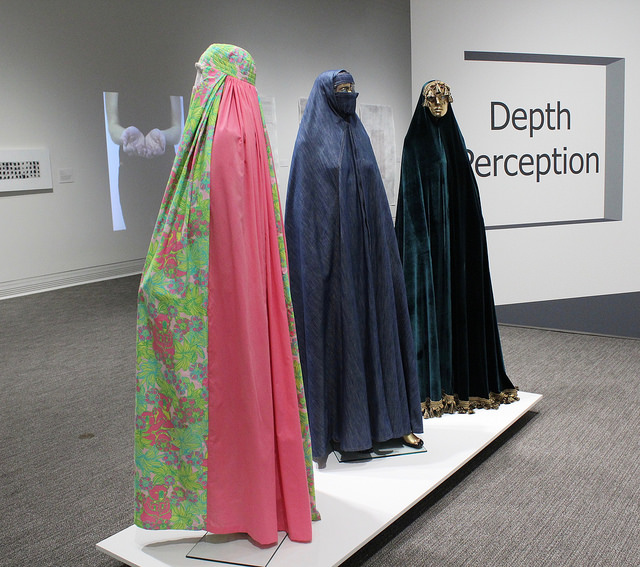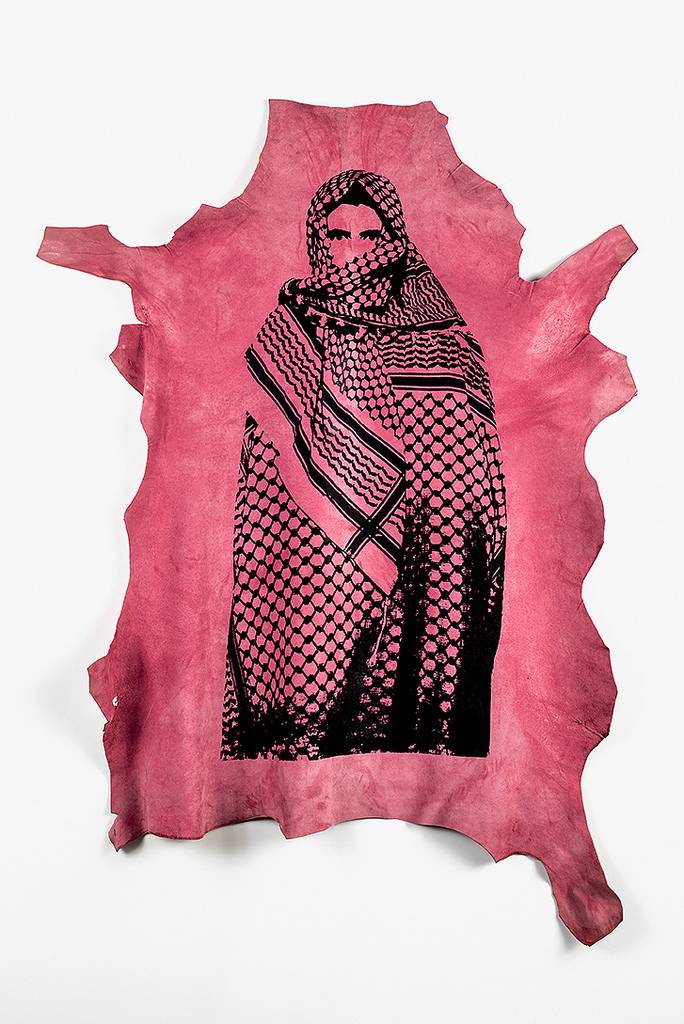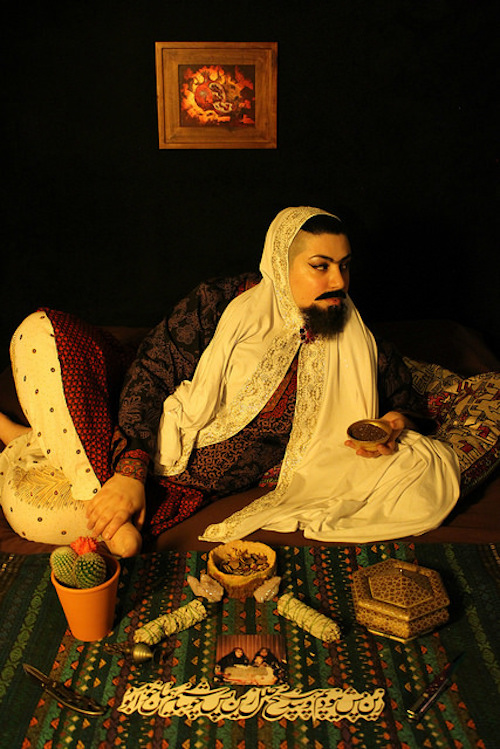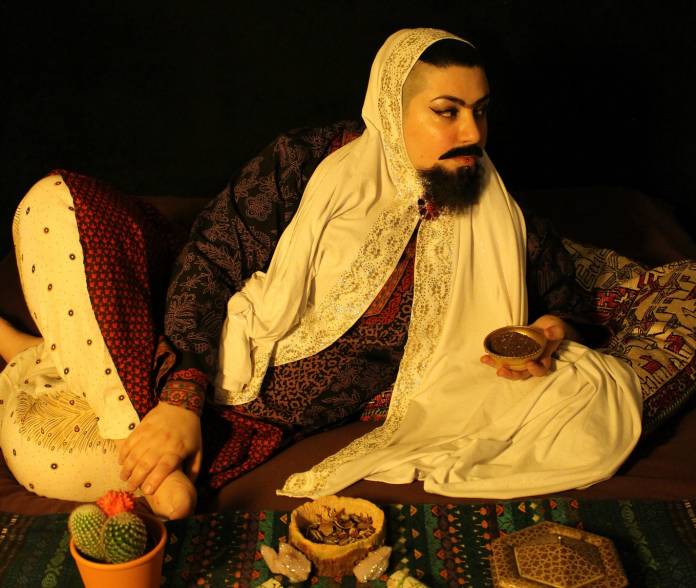“The diversity of queer and trans* Muslim experiences cannot be limited,” says Zulfikar Ali Bhutto, co-curator, with Yas Ahmed, of provocative and necessary new SomARTS show “The Third Muslim: Queer and Trans* Muslim Narratives of Resistance and Resilience” (January 25-February 22, opening reception Thu/25, 6pm-9pm, free.)
“The Third Muslim” features work by more than a dozen artists ranging from Syrian to Somali to Pakistani heritage, but there’s even more that reveals the multiplicity of Muslim and queer experiences: “We have a panel people of faith, kink, and fashion,” Ali Bhutto told me, “and a closing performance that speaks of the experience of coming out as Muslim in the United States.”
LGBT Muslim-Arab artists (mostly gay men) who address both faith and sexuality are starting to gain attention in the US—a recent, sweeping article in the New York Times on the topic mentions “The Third Muslim” and features one of its artists, the fantastic Jamil Hellu. The SOMArts show reaches even further, highlighting “struggles common among contemporary Muslim queer, trans* and gender non-conforming communities, regardless of locale, including displacement, diaspora, and hyphenated identities.”
It also addresses, in Ahmed’s words, “the Arabization of Islam” (aka the reduction of Islam to a stereotypically Arabian phenomenon—as Ahmed notes, the first Muslims in America were black African slaves), challenges “gender-based oppression within Islam” itself and “racism (specifically, colorism and anti-blackness) and Islamophobia within mainstream queer and trans* communities.”
That’s a lot! I spoke with curators Ali Bhutto and Ahmed about their vision for the show, the necessity of creating space for artists to speak for themselves, and, as Ali Bhutto put it, “the labor involved in trying to broaden people’s perspectives.”

48 HILLS You’re both deeply involved in the arts community. Please tell me a little bit about yourselves and your background.
ZULFIKAR ALI BHUTTOI am a visual and performance artist, a drag queen who goes by the alias Faluda Islam, and a curator of mixed Pakistani, Lebanese, and Iranian descent. My work in a general sense explores issues of state violence and how that violence resonates in our collective memory, how it forms and shapes communities, and by extension how it affects the individual. In my curatorial work, I take it as an opportunity to organize and explore important issues around identity, place and the needs of the time.
YAS AHMED It’s been both my activism and my art, which is writing, that has saved my life over and over. As a multiracial (Yemeni, Somali, Lebanese, German) genderqueer person, I often write about the intersections of these experiences, because I believe in the effect of storytelling. My art and my activism are founded on a deep belief that building power among marginalized communities is as critical to our collective well-being as people, as much as it is to our collective imaginations as artists. Five years ago I co-founded MASGD, the Muslim Alliance for Sexual and Gender Diversity.
48H What was the genesis of the idea the show? Was there a particular event or series of events that sparked its conception?
ZAB I think it mostly came from a need to both find community and also to make sure that not only were our (queer and trans Muslims) voices being heard but that we were representing and speaking for ourselves. Muslims in general, and queer and trans Muslims specifically, are often spoken about and for in the media: judged, assessed, silenced, and vilified. We have voices, and we can speak for and represent ourselves through many means—in this case, creatively. This show was a long time in the making, brewing in both our brains for a while.
YA The core issues The Third Muslim engages—identity, displacement, diaspora, the many types of violence enacted on bodies from people who are Muslim, queer and or trans*—have existed, alongside the stories of people resisting and fighting back, long before Trump, before 9/11. So in many ways, this exhibition is overdue. As writer adrienne marie brown shared some time ago, things aren’t new, they’re just becoming uncovered. These things—Islamophobia, racism, gender-based oppression—are not new for our communities. Neither is survival, or the complex ways we heal and sustain ourselves and each other, including building community, including creating socially-engaged art. So, when a practical opportunity arose for us to help shape a platform of what some of those stories of resistance have been, currently are, unveiling a range of what it even means to be queer, trans* and Muslim-identified these days, we jumped on it.

48H What is the concept of “The Third Muslim”?
ZAB The Third Muslim refers to the multitude of Muslim identities that can and do exist in the world. It is us stepping out of the binary that stereotypes Muslims as either extreme or moderate and that somehow if you don’t fit into that binary then you are outside of Islam. This show aims to challenge that, it reveals not only a third Muslim, but also another way to see Islam, its practices and in the case of this show even queerness and trans-ness* and the identities that exist within it.
YA At its core, it’s inviting people to try on another way of making meaning. I often like to say that queer and trans* Muslims are on the margins of the margins. We’re the in-between, the outside of, existing within understandings of Islam as monolithic, of queerness as white or western or cisgender or able-bodied, of Muslim as other—we exist in this THIRD space, in our full dignity and power. There is an Islamic concept of itijihad, which, crudely interpreted, means an ongoing practice of critical thinking and spiritual examination. This, to me, is what “the Third Muslim” is.
48H With 14 exhibiting artists ranging from Syrian to Somali to Pakistani heritage, and representing a plethora of identities, this show seems like it will really help reveal the vast diversity behind the monolithic stereotype of Islam. How did you find the artists, and how did you define “Muslim” for the show’s purposes?
ZAB “Finding” the artists was, I think, a rather organic process, Yas and I have both been working within LGBTQ Muslim communities for a while, be it creatively, academically, within social activism, and so on. In the beginning we both pulled from our resources but we later realized that we wanted to know that we weren’t leaving anybody out of the conversation. There are so many important voices out there, and we knew it was important to be able to include as many as we could. So we put out an open call that pretty much went all over the world—and it finally struck us how much of a movement this really was.
YA We didn’t define Muslim for the show—we encouraged artists to define their relationship to queer, trans*, Islam identities for themselves. Some connect spiritually, politically, culturally, ideologically… Some connections are tentative or recovering or new. We wanted to take care that there was space for wherever folks entered these identities and experiences. Even though our own intention in this exhibition was lifting up stories and voices who are often invisibilized, there is still far more work to do.
For example, in my experience many of the US-based spaces for queer and/or trans Muslims tend to be heavily South Asian and/or Arab—this is an extension of the reality of the Arabization of Islam as a practice around the world. As a mixed race Arab, it’s my responsibility to push back against that—the first Muslims on this land were enslaved Africans, black people. How are we making space in exhibition and as artists to listen to voices and support work from silenced perspectives, on issues that are as contemporary as historic—e.g. how are we talking about anti-blackness within non-Black Muslim communities? This is our responsibility as creators and curators of socially engaged art.

48H The show promises to address Islamophobic stereotypes and expressions in the mainstream GLBT community, which I feel is so necessary. Do you have any stories you could share of your own personal experience with this?
YA My personal experiences aren’t the focus of this exhibition at all, so I don’t feel comfortable sharing details on that. I will say that, from my perspective, queer and trans* communities in San Francisco, Oakland, the Bay Area are AS susceptible to Islamophobia, misogyny, racism, anti-blackness, cisgender bias, able-bodied bias, xenophobia—as queer and trans* communities anywhere else. Certain bodies, experiences are privileged over others, and this is rampant in the way we shape desire, build community and spaces. Both erasure and respectability politics are alive and well here.
ZAB I’d like to agree with Yas on this one but I will say that being more or less active within queer nightlife in this city means your exposed to a lot. As a drag queen, I’ve performed in the Castro, SOMA, Oakland etc… and a lot of the work I do talks about Islamophobia using a mix of some real life stuff and humor. I’ve had many people make many offensive outright Islamophobic comments and others that may not always be done with malicious intent, they also come out of genuine ignorance and very hard-to-defeat assumptions people hold on to. There is a lot of labor involved in trying to broaden people’s perspectives, which is not only why we are having an arts exhibition but also why we are having a panel, a gift essentially, allowing people to listen, ask questions and respond to queer Muslims who represent diverse perspectives and lifestyles.
48H It so often falls upon queer people to transform a tradition from within, while simultaneously representing and defending that tradition to outsiders. Is this (often relentless and exhausting) work/tension particularly reflected in the artists’ work in the show?
ZAB I think it really depends on the perspective and on the artist. We come from traditions, families, and cultures that we love and cherish and we want to hold those cultures while still being true to ourselves. We are at a crossroads, often misunderstood by our own communities and a wider LGBTQ circle. Especially in the US, queerness and Islam are often seen as opposed to each other. In this show we welcome broad perspectives and you definitely see a lot of different ways of seeing Islam and its relation to queerness, cultural affinity, and so on.
YA Again, the path looks very different depending on whose viewfinder you are peering through. I agree with Zulfi here in that queer and trans* Muslims relationships to notions of tradition, culture, family, ritual are vast and varied. Experiences of “coming out”—often very defined in white, western context – can sometimes even be of “coming out” as Muslim. Sometimes it means just simply being, living in integration, inhabiting all of ourselves without explanation or defense. What I appreciate about the stories and work in this exhibition is that sometimes we are called upon to even question who the outsider is in this conversation. Because it isn’t us 😉
THE THIRD MUSLIM
Opening reception Thu/25, 6pm-9pm, free.
Show runs though February 22
SOMARTS, SF
More info here.
Additional events:
Queering Islam: A Conversation
Thursday, February 8, 6pm–8pm
A panel conversation representing an intergenerational, multi-identity group of community members who have made their own paths as queer Muslims in the realms of faith, fashion, leather and kink, often creating their own meaning and (sub)communities where none existed before. To learn more, visit www.somarts.org/thirdmuslimpanel.
Closing Reception and Performance
Saturday, February 17, 1pm–4pm
Featuring Coming Out Muslim: Radical Acts of Love, co-conceived and performed by Wazina Zondon and Terna Hamida, the closing reception and storytelling performance will be accompanied by a talkback with audience members subsequent to the performance.




